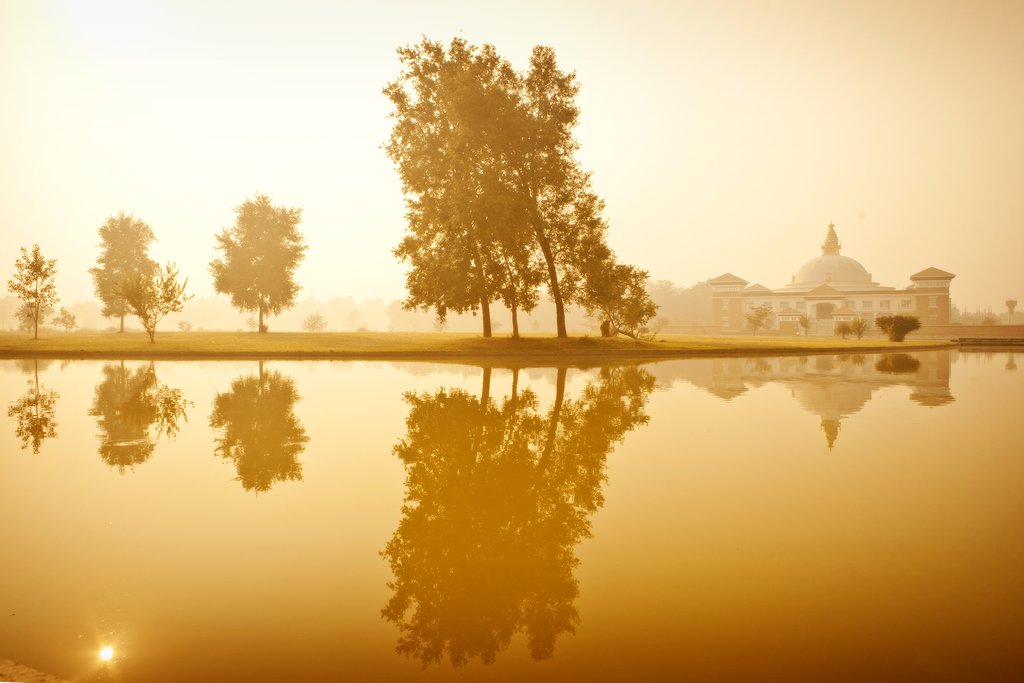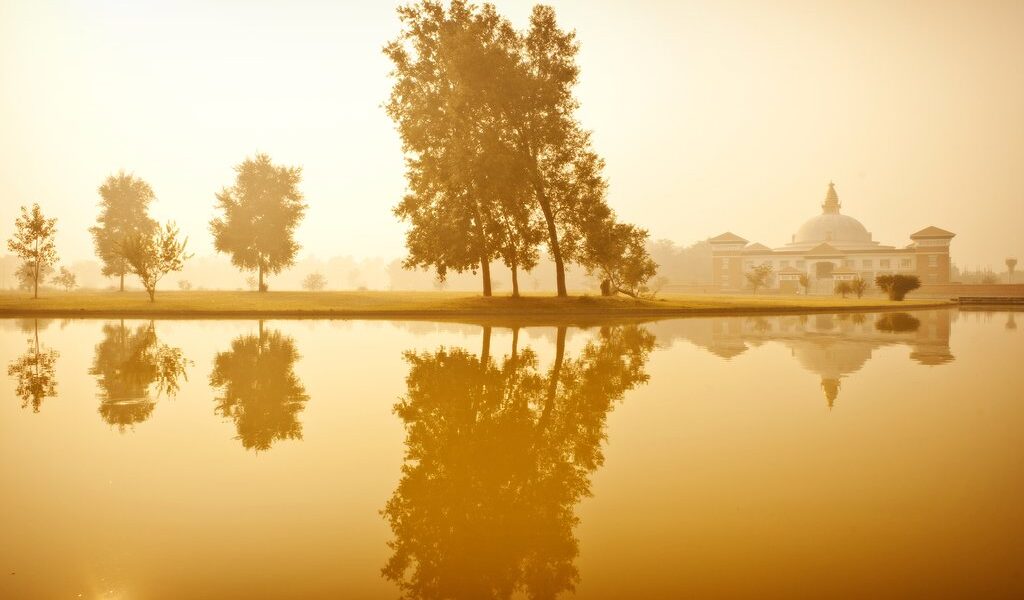
When visiting Nepal, it’s easy to set your sights firmly on Mt. Everest, Kathmandu, and Chitwan National Park — but don’t overlook the religious site of Lumbini. As the birthplace of the Buddha, this is one of the world’s great pilgrimage destinations. If you’re interested in history, spirituality, or archaeology, add Lumbini to your Nepal wish list.
## A Journey Through Time: Exploring the Sacred Grounds of Lumbini
Lumbini, a name whispered with reverence and steeped in history, holds profound significance for millions across the globe. Its importance stems from a single, transformative event that occurred here over two and a half millennia ago: the birth of Siddhartha Gautama, the prince who would later become known as the Buddha, the “Awakened One.” This sacred site, nestled in the heart of Nepal, marks the very place where a future spiritual leader entered the world, forever changing the course of history.
A modest plaque, unassuming yet powerful, and a weathered stone stand as silent witnesses to this momentous occasion. These markers denote the precise location where Queen Maya Devi, according to tradition, grasped onto a branch of a *bodhi* tree while en route to her ancestral home in Kapilavastu. It was beneath the shade of this sacred tree that she gave birth to the prince, an event that would ripple through the ages, shaping philosophies and inspiring countless individuals.
However, the passage of time has not been kind to all memories. For over a thousand years, Lumbini lay lost to the world, shrouded in obscurity. As Hinduism and Islam rose to prominence, gradually supplanting Buddhism as the dominant faiths across the Indian subcontinent, the birthplace of the Buddha faded from collective memory. The once vibrant center of spiritual significance was swallowed by the sands of time.
The rediscovery of Lumbini in the 19th century was a triumph of historical investigation and dedicated exploration. A local Nepali governor, driven by a thirst for knowledge, joined forces with British archaeologists of the Raj era to embark on a quest to unearth the lost site. Their success hinged on a meticulous comparison of written accounts left behind by medieval Chinese pilgrims with the inscriptions they meticulously deciphered from ancient sandstone pillars that had stood sentinel over the forgotten landscape for two thousand years.
Today, Ashoka’s pillar, adorned with vibrant marigolds and reverent offerings, stands proudly in front of the Maya Devi Temple. This majestic pillar serves as a tangible reminder of the zenith of Buddhism, a time when the faith reigned supreme across a vast territory stretching from Peshawar to Patna. The pillar is more than just a monument; it’s a symbol of a rich and complex history, a testament to the enduring power of spiritual beliefs.
Stepping into the present, the expansive Lumbini complex unfolds before the visitor, a sprawling testament to the enduring legacy of the Buddha. This grand site, stretching three miles (4.8 km) in length, is now a designated UNESCO World Heritage Site, recognized for its unparalleled cultural and historical significance. Within its boundaries lie a treasure trove of spiritual and architectural wonders.
The Lumbini complex encompasses a diverse collection of monasteries, each reflecting the unique architectural styles and cultural traditions of various Buddhist countries. These monasteries stand as vibrant expressions of devotion and artistic ingenuity, showcasing the global reach and enduring appeal of Buddhism. The sacred Bodhi tree, a direct descendant of the tree under which Queen Maya Devi gave birth, offers shade and serenity for reflection. An ancient bathing pond, believed to be where the queen and her newborn infant took their first bath, evokes a sense of connection to the past. And of course, the renowned Ashokan pillar, a silent observer of history, continues to inspire awe and reverence. The **Mayadevi Temple**, the heart of Lumbini, draws pilgrims from far and wide.
In keeping with the central tenets of Buddhism, the atmosphere within the Lumbini temple complex is remarkably peaceful and unhurried. Visitors are greeted by a steady stream of pilgrims, hailing from Burma, Thailand, and China, who approach the main shrine with hushed reverence. Despite the constant flow of devotees, the site never feels overwhelming or crowded. The air is thick with a sense of tranquility, inviting introspection and contemplation.
While Lumbini may not boast opulent displays of architectural grandeur, its true splendor lies in its profound spiritual significance. Remnants of ancient brick stupa bases and the walls of long-gone monasteries offer glimpses into the past, but the true essence of Lumbini lies in its ability to inspire meditation, contemplation, and deep reverence. This is a place where the material world fades into the background, allowing visitors to connect with something larger than themselves. It is a place where bling has no place, where the focus is firmly on inner peace and spiritual growth.
Reaching this haven of tranquility requires a journey, and several routes lead to Lumbini. A five-hour drive from Pokhara offers a scenic overland experience. Alternatively, a short flight from Kathmandu to Bhairahawa, followed by a brief drive, provides a quicker and more convenient option. Lumbini’s proximity to the Indian border makes it easily integrated with a broader pilgrimage across India’s Uttar Pradesh state. Here, travelers can visit the sacred Buddhist sites of Kushinagar, where the Buddha passed away, and Sarnath, where he delivered his first sermon. The captivating city of Varanasi, a perennial draw for seekers of enlightenment, is also within easy reach.
The climate of Lumbini, situated in the Terai plain, dictates the optimal time for visitation. The cooler winter months, spanning from November to March, offer the most pleasant conditions for exploring the site. Due to limited accommodation options in the immediate vicinity, it is advisable to make hotel reservations well in advance to ensure a comfortable stay.
Navigating the vast expanse of the Lumbini complex can be achieved in several ways. While walking allows for a leisurely exploration of the grounds, renting a bicycle provides a delightful and efficient way to traverse the distances between the various monasteries and points of interest. A half-day spent cycling from one temple to another is an experience that should not be missed.
Begin your cycling tour at the impressive Burmese-style golden pagoda, a shimmering testament to Burmese artistry. Continue your journey past the exquisitely ornate Cambodian temple, a vibrant expression of Cambodian architectural traditions. Next, immerse yourself in the serenity of the Sri Lankan monastery, where monks offer pilgrims sacred white threads, symbols of blessings and protection, to be tied around their wrists. You will soon encounter a colossal Tibetan-style stupa, standing proudly alongside a Chinese-style temple reminiscent of Beijing’s Forbidden City. This eclectic mix of architectural styles provides a captivating visual representation of how Buddhism has adapted to and integrated with diverse local cultures as it spread throughout East Asia. It’s a testament to the faith’s ability to transcend geographical boundaries and resonate with people from all walks of life.
Beyond the immediate confines of Lumbini, other sites of historical and spiritual significance await exploration. Siddhartha, before becoming the Buddha, lived as a prince in the kingdom of Kapilavastu. Today, visitors can wander among the ruined city walls of his former palace, gaining a tangible sense of his early life. A taxi ride, lasting approximately one hour, will transport you east of the main shrine to this historical site.
Upon arriving at Kapilavastu, make your way to the foundations of the Eastern Gate. It is here, at this very spot, that the 29-year-old prince made the momentous decision to renounce his royal life. He cast off his princely robes, mounted his horse, and rode out of the city, leaving behind his wife and child to embark on a six-year quest for enlightenment. This unassuming location holds immense global historical importance, marking the beginning of a journey that would forever alter the course of spiritual history.
Other archaeological sites in the surrounding area offer further insights into the life and times of the Buddha and those who came before him. Two more pillars, erected by Ashoka, mark the birthplaces of previous Buddhas, connecting Lumbini to a lineage of spiritual leaders. At nearby Kundan, visitors can explore three stupas that commemorate the Buddha’s reunion with his father, wife, and son after achieving enlightenment. It was also in Kundan that the Buddha inducted his son into the fledgling Buddhist faith, marking a pivotal moment in the transmission of his teachings.
Upon returning to Lumbini, there is no better way to conclude your visit than by spending a quiet hour within the peaceful grounds of the temple. Use this time to delve into an introductory text on Buddhism, meditate on the teachings of the Buddha, or simply sit quietly and absorb the profound atmosphere of the site. In the realm of travel experiences, this may well be as profound as it gets, offering a chance to connect with history, spirituality, and the enduring legacy of Lumbini.
B-1769

